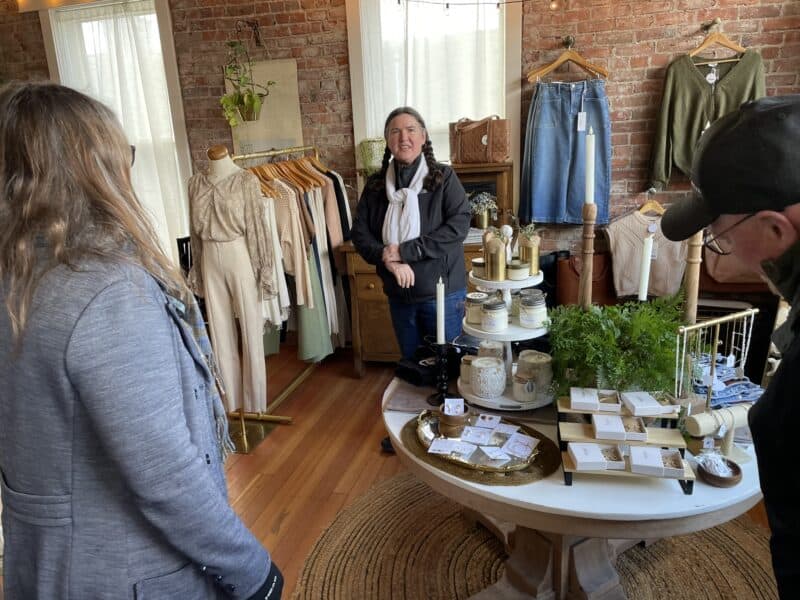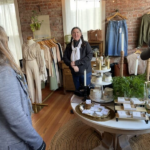Monthly Archives: December 2024
TREND 2025: Retail’s Big Split: what small town retailers can do now
Remember the Retail Apocalypse around 2017? In a media interview this week, I brought up that it was actually Retail’s Big Split, not an apocalypse, and it’s ongoing. The reporter asked me to explain, so here’s my update for today’s retail landscape. “Everything gigantic in American life is about to get smaller or die.” […]
Remember the Retail Apocalypse around 2017? In a media interview this week, I brought up that it was actually Retail’s Big Split, not an apocalypse, and it’s ongoing. The reporter asked me to explain, so here’s my update for today’s retail landscape.

This combination business offers tiny spaces to retail pop-ups along with coffee and sweet treats. It offers plenty of meaningful, interesting purchases in this historic building in Potlatch, Idaho. Photo by Ana Blaisdell.
“Everything gigantic in American life is about to get smaller or die.” James Kunstler wrote in 2013. He said big box retailers were on the brink of scale implosion, and that “every element of economic reality is now poised to squash them.” It was a provocative stance for 2013, and I’ve been monitoring small retail trends at least as long.
By 2017, it seemed like we went over the brink. Every week brought another story of big retail jobs lost, the shuttering of stores, and the financial losses at big retailers.
You might think small retailers, especially small town retailers, don’t stand a chance. But that’s not true.
There are a lot of news stories that point to eCommerce as the cause of big in-person retail’s decline and also as its replacement. Today, you don’t run to the big box store for regular items like paper towels or laundry soap. You just tell your voice assistant to order it online. Even more automated, you’ve probably set up all kinds of regular items on recurring shipments that you don’t even think about. Smart refrigerators can already integrate with your voice assistant to make it easy for you to place more orders. Soon the fridge itself will notice you’re low on something and just reorder it for you. That means no chance for a big box store to capture an impulse purchase when you make a quick run to the store for those items.
It’s worth noting that online sales today only amount to 16% of all retail sales, though that has doubled since I first wrote about the Big Split in 2017. Online sales aren’t the only cause for big retail’s decline or the only replacement. We’re also purchasing less for a variety of societal and cultural reasons. See also the Buy Nothing group you belong to on Facebook, underconsumption core, and thriving interest in sustainability, secondhand and vintage shops. But that still leaves a lot of purchases being made, just not as much at big boxes and not all online.

Small town retail still brings meaning and charm to everyday purchases, like this store in Rosthern, Saskatchewan. Photo by Becky McCray.
Where are the rest of sales going? Small retailers.
While all boring retail purchases get automated, interesting retail purchases become small, sustainable, curated, handcrafted, local and integrated with technology. Items we care about, are interested in, and want to enjoy shopping for, will come from small local retailers.
Author David Sedaris summed up this consumer feeling in an interview:
“I’d rather go to an actual shop — preferably a small one — than to a harshly lit superstore, or, worse still, a website,” Sedaris said. “I don’t want to buy my books and my toilet paper and my clothing all under the same roof. I want beauty in my life. I want charm. I want contact with actual people. It is, for me, a large part of what makes life worth living.”
The MasterCard SpendingPulse for Small Business reported on the “general consumer trend to shop small” for years. IBM Research predicted local retailers’ increasing use of technology.
Smart local stores today do both digital and physical retail. The physical store is close to customers for immediate gratification. Local business owners tell us on the Survey of Rural Challenges that they add the product information and reviews of online, plus the data to be more personalized, like wishlists and recommendations. Local stores bring the product right to where the shopper can physically touch it.
Classes and hands-on activities turn shopping into a memorable experience. That’s a layer of meaning that no big box store or online order can duplicate.

The experience of visiting a converted barn, shopping dozens of local artisans, and even joining a hands-on class brings more meaning to every purchase from the Artists at the Dahmen Barn in Uniontown, Washington. Photo by Becky McCray
What can local stores in small towns do today to capitalize on retail’s big split?
-
Use big retail’s own tools against them. Try these 7 big-retail tricks including automatic orders, delivery, and better recommendations.
-
Add more technology to be more human. Use tablets to improve your service. Teach customers how to buy from you through Alexa and Siri.
-
Offer experiences and items that can’t be bought online. Locally-produced items, personalization and special services give you an advantage. In store classes, demonstrations and hands-on crafts are memorable experiences.
-
Be your best small town self. Use your 7 Strengths as a small town retailer and shore up these 7 Common Weaknesses of Local Shops.
You don’t have 52 weeks this year
By Rob Hatch Thirty-six weeks. Part of my process for planning my business for the New Year is to do a little reality check on exactly how much time I have to work with. What are you talking about, Rob? You have a year. Technically, that’s true. However, on closer inspection, I only have 36 […]
By Rob Hatch

Thirty-six weeks.
Part of my process for planning my business for the New Year is to do a little reality check on exactly how much time I have to work with.
What are you talking about, Rob? You have a year.
Technically, that’s true. However, on closer inspection, I only have 36 FULL weeks available.
36 is the new 52
My process is pretty simple. I set up a spreadsheet listing every week in 2025. Right off the bat, you’ll notice that the first whole week begins on January 6th.
Next, I block off the weeks when I know I will be on vacation and spending time with friends and family.
Then, I note each week a holiday or personal event occurs that will limit the time I have available for work.
I noted weeks when my children are on school break, and I want a lighter work schedule.
I look at the seasonal ebbs and flows of our family life, such as when we begin and end the school year.
Taking all that into account, I was left with 36 full weeks.
Thirty-six weeks is a very different number to work with than fifty-two.
Here’s what I found most helpful about this exercise.
1. I am starting my annual planning by prioritizing time with my family. I am deciding ahead of time to set aside significant time for that.
2. Many of the other weeks (holidays, school vacation, weeks of transition) will happen regardless. By planning for them, I can plan around them.
3. As I look at what I want to accomplish next year, I have a clear picture of the time resources available to commit to achieving them.
Thirty-six full weeks.
Your number will likely be different. The point is to figure out your number and plan accordingly.
Boost your co-working space with social hours
When I visited Caldwell, Kansas, the manager of the co-working site said they had filled their private offices, but struggled to attract day users. People who work from home like working from home. They don’t want a full time office, so they said they don’t want to use the coworking space. How can the coworking […]

The Caldwell Workspace is on the right. Photo by Becky McCray.
When I visited Caldwell, Kansas, the manager of the co-working site said they had filled their private offices, but struggled to attract day users.
People who work from home like working from home. They don’t want a full time office, so they said they don’t want to use the coworking space.
How can the coworking space attract those work-from-home folks?
Promote the “co” part more than the “working” part.
At their best, co-working spaces are human spaces, Emergent Research has been saying for ten years now. Studies found that people who use co-working say it makes them less lonely. That’s the part to talk about, much more than the fact that you can work there.
Start by providing your work-from-home people with social hours and temporary events so they can connect and build community with each other. That will help their wellbeing right away. Plus, as long as they’re in the space, they’ll look around and found out more about the space and the services it offers.
Social hours also give you (the manager of the space) a chance to ask more about what they do, what they want and need. Do they want day time hangout events? Are they eager to be social? Do they really just need a copier? I don’t know, but they’ll tell you when you get them together to Build Connections. (That’s Idea Friendly, of course.)
Bonus: you can bring in business supporters like the chamber of commerce or advisors like the Small Business Development Center. When they meet each other in an informal setting, they may be more likely to connect.
Schedule a social hour, and set a goal of three people attending. Even three people is enough to start building community. Put the word out all the ways you know how: local Facebook groups, the chamber of commerce email newsletter, signs around town, and text some friends. Take a lot of pictures so you can use them to promote the next one.
Then try another one, maybe at a different time or a different day. Experiment. Take Small Steps. (That’s Idea Friendly, too.) Let me know how it goes.
Learn more
Find more practical steps you can take in SaveYour.Town’s video Remote Work Ready: Zoom Towns. Everything you’ll learn is do-able, affordable and scaled for small towns.


